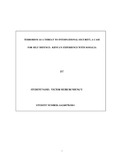| dc.description.abstract | Chapter one deals with background, literature review and theories of self defense generally to expose gaps, distortion or different perspectives on the right of self defense vis a vis terrorism. This chapter sought to answer: 1) What does the literature says on the scope of the acts that constitute a threat to international peace and security?
2) What does the literature says about the relevant international institution that should respond to emerging threats?
3) Has the new threat altered the established understanding of self defense?
In the analysis I have relied on reports, scholarly journals, text books and articles in regard to terrorism and Kenya’s incursion into Somalia.
Chapter two deals generally with right to self defense as provided for in the UN Charter. It looks at how right to self defense was practiced prior to and during the time of UN Charter. This chapter sought to answer the following questions:
1) What is the role of UN in fight against terrorism?
2) What are the emerging states’ practices against terrorism and piracy?
3) How has Kenya reacted to threats posed by terrorism and piracy from Somalia?
In this analysis I have relied on various UN Resolutions in regard to terrorism and further on journals on how they have reported the trends of states practice on the use of force against terrorism.
Chapter three deals with the problems posed by terrorism in Kenya and outlines methods that Kenya has taken in response to these threats. This chapter sought to answer the following questions:
1) What is the current security situation in Somalia?
2) What is the impact of the terrorism from Somalia into Kenya?
3) What is the recourse taken by Kenya in the fight against terrorism?
I have relied on newspapers and various reports by UN and other institutions that have reported on the issue of Kenya and the terrorism from Al shabaab.
Chapter four ends with conclusions and recommendations. It gives insights with regard to Kenya’s right to self defense in the face of terrorism from Somalia. This chapter has answered questions posed by chapter one, two and three. On giving recommendations I have borrowed heavily from Rome Statute, UN Charter, Kenya’s statutory law and the global trend on the best practices in fighting terrorism as has been reported via
various journals, articles, reports, amongst others. I have recommended the way forward as prosecutions, self defense or surveillance | en |

